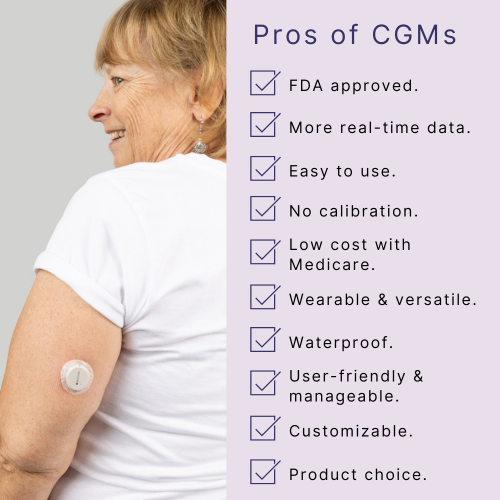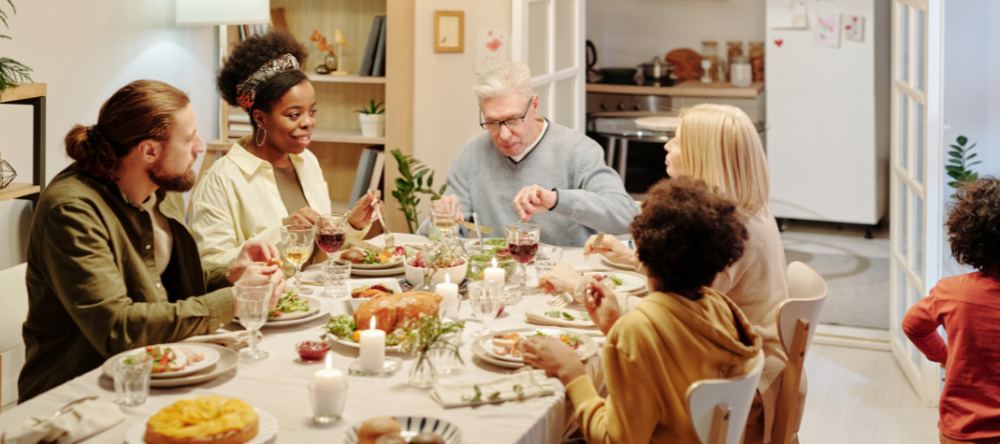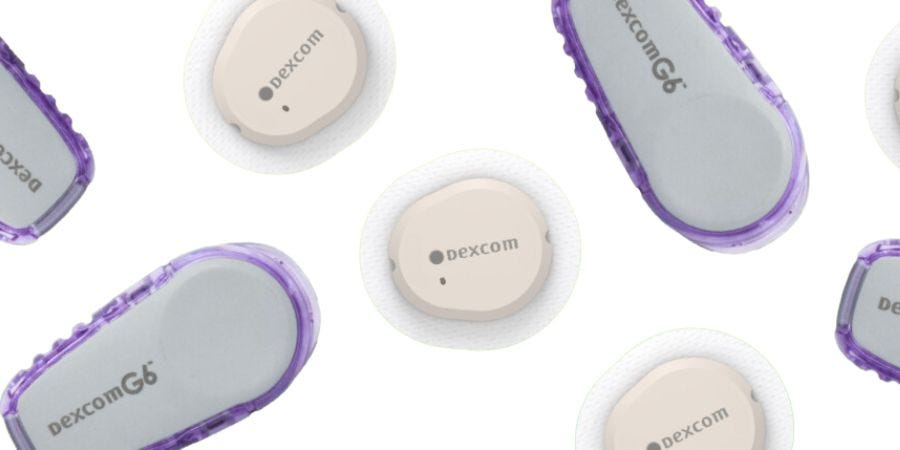Key Takeaways:
-
CGMs are customizable, easy to use, and have many more benefits, making them an excellent choice for people with diabetes.
-
Those with a diabetes diagnosis may be able to get CGMs at low cost with Medicare or other private insurance plans with Aeroflow Diabetes.

Whether you're a seasoned CGM user or contemplating its integration into your diabetes care routine, understanding the pros and cons of these systems is crucial for making informed decisions for the best quality of life possible.
Let's explore the benefits and potential drawbacks associated with CGMs so you can determine if they're the right fit for you or your loved one.
What Are CGMs?
Continuous glucose monitoring systems (CGMs) are wearable devices that monitor your glucose levels in real-time. CGMs consist of 3 parts:
-
Sensor: The part of the CGM system you wear to measure interstitial fluid. Sensors are placed just under the surface of the skin.
-
Transmitter: Receives glucose readings from the sensor and sends them to the reader in real time.
-
Reader: Handheld display devices that receive glucose readings from the transmitter every few minutes. Readers come with your CGM system, but you can also use your mobile device.


What Are the Benefits of Using CGMs?
If you have type 1 diabetes or type 2 diabetes, you know that diabetes management can sometimes be tedious. Glucose monitoring is the most crucial aspect of diabetes care, but it can be time-consuming and painful to use fingerstick tests. Thankfully, diabetes technology has advanced, and you can now use painless CGM devices to receive accurate glucose data.
- FDA approved. The glucose data from your CGM can be used to make treatment decisions, usually without the need for a fingerstick.
- More real-time data. CGMs are worn constantly, allowing you to monitor glucose levels anytime, anywhere, giving you more accurate data. You can also store months' worth of data on your reader.
- No calibration. Newer CGM systems don't typically require you to calibrate them like some older models do.
- Low-cost with Medicare. CGMs are available at low cost through Medicare with Aeroflow Diabetes.
- Wearable and versatile. Sensors can be worn in different places, like your belly or upper arm, depending on your CGM. You can wear them while exercising, sleeping, and other activities.
- Waterproof. CGMs are waterproof, so you can wear them while swimming or showering.
- User-friendly. You can choose how and when you want to receive your glucose readings; use your mobile device or reader and check your levels at any time.
- Customizable. CGMs have customizable functions that allow you to set alerts when entering periods of hypo or hyperglycemia.
- Product choice. CGM users can choose from different CGM systems, including the Dexcom G7 and the FreeStyle Libre 3 System.
- Manageable. Caregivers of loved ones with diabetes will find that using CGMs is much easier than using fingersticks to monitor glucose readings. Using a compatible smartphone to view readings also allows you to share data with your caregiver’s phone, giving you more peace of mind.
What Are the Cons of CGMs?
There are only a few negatives regarding CGM use, but we've listed a few.
- No insulin. Unlike insulin pumps, CGMs can't administer insulin. However, CGMs can be used with insulin pumps.
- Possible calibration. Older CGM systems may require calibration, which means you may need to test your results against those of a finger prick test. However, newer CGMs don’t require calibration.
- High cost. Without using Aeroflow Diabetes to receive your CGM through Medicare or a private health insurance plan, the devices can be expensive out of pocket. Ensure you get your CGMs at low cost through Aeroflow Diabetes!
- Visible. You may sometimes feel uncomfortable if other people can see the sensor on your body.
- Lots of learning. Setting up your CGM and learning how to customize and share readings may be overwhelming initially. However, if you receive your CGM through Aeroflow Diabetes, you’ll have access to live, one-on-one training to help set up your system, as well as ongoing access to a CGM Specialist who can answer any questions you may have.
CGMs let you know your current glucose readings and what they've been like in the past, giving you the knowledge you need to stay healthy. If you want a fast, efficient, easy way to take back control of your diabetes care, a CGM may be right for you.
Can You Get CGMs at Low Cost With Medicare?
If a healthcare provider has prescribed your CGM, you may be able to receive some of the best CGM systems through major and private health insurance plans or Medicare with Aeroflow Diabetes.
Some insurance plans fully cover CGMs, while others will cover 80% of the cost, in which case, you'd pay for the remaining 20% after your deductible is met. The out-of-pocket cost of your CGM will vary depending on your specific insurance plan.
To be eligible for a CGM through Medicare, you'll need to meet the following requirements:
-
Have a diabetes diagnosis.
-
Inject insulin at least 1x daily, or have one or more hypoglycemic events documented by your HCP.
-
See a healthcare provider at least every 6 months.
Fill out our secure Eligibility Form today to see if you qualify for low-cost CGMs through Medicare.
Disclaimer
Information provided on the Aeroflow Diabetes website is not intended as a substitute for medical advice or care from a healthcare professional. Aeroflow recommends consulting your healthcare provider if you are experiencing medical issues relating to diabetes care.










